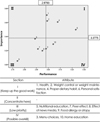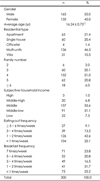Abstract
Purpose
This study investigated the importance and performance of food/nutrition labeling. The aim was to determine how important students consider food nutritional labeling, utilization of nutrition labels in daily life, and consumer satisfaction of current nutritional labeling.
Methods
This study was conducted using a primary survey of students at one high school in Seoul. A total of 300 of 382 questionnaires were analyzed.
Results
Regarding difference analysis of the importance-performance of food/nutrition labeling, importance showed higher scores than performance in all 10 attributes. According to the results of Importance and Performance Analysis (IPA), ‘health, weight control and maintenance, proper dietary habits, and personal satisfaction’ displayed both high importance and performance in the first quadrant. Importance of two factors (health and nutritional factor and effects of media and education) of the 10 attributes positively influenced overall satisfaction in the multiple regression analysis.
Figures and Tables
References
1. Kim YS, Kim BR. Intake of snacks, and perceptions and use of food and nutrition labels by middle school students in Chuncheon area. J Korean Soc Food Sci Nutr. 2012; 41(9):1265–1273.

2. Kang HN, Shin EJ, Kim HN, Eom KY, Kwon KI, Kim SY, Moon GI, Kang BW, Kim JW. Food nutrition labeling (processing food, food service business) in Korea. Food Sci Ind. 2011; 44(1):21–27.
3. Kwon KI, Yoon SW, Kim SJ, Kang H, Kim HN, Kim JY, Kim SY, Kim K, Lee JH, Jung SM, Ock SW, Lee EJ, Kim JW, Kim MC, Park HK. A survey on customers' perceptions of nutrition labeling for processed food and restaurant meal. Korean J Nutr. 2010; 43(2):181–188.

4. Jeong JY, Kim E, Yang IS, Ham S. Restaurant manager's awareness of and satisfaction with menu labeling at restaurants. J Foodserv Manage. 2014; 17(4):247–265.
5. Ministry of Food and Drug Administration. Guideline for nutrition labelling. Cheongwon: Ministry of Food and Drug Administration;2012.
6. Food Standards Agency (GB). Front of pack nutritional signpost labelling technical guidance. London: Food Standards Agency;2007.
7. Chung HJ, Cheon HS, Kwon KI, Kim JY, Yoo KS, Lee JH, Kim JW, Park HK, Kim SH, Hong SM. The recognition and requirement of nutrition labeling in fast-food restaurants. Korean J Nutr. 2009; 42(1):68–77.
8. Han MH, Choi KB, Lyu ES. Study on consumption patterns and degree of checking food-nutrition labeling of convenience foods at convenience stores by young adult workers in Busan. J Korean Soc Food Sci Nutr. 2014; 43(2):309–317.

9. Park S, Kim SJ, Kim B, Yoon H, Hong JM, Ahn YS, Kim JS, Han SB, Yoon Y, Joo N. Consumer awareness and institutionalization of nutrition labeling for Takju. Korean J Food Cult. 2013; 28(1):89–98.

10. Kim JH, Lee KT. Studies on the current status of nutrition labeling recognition and consumption pattern of domestically processed meat products. J Korean Soc Food Sci Nutr. 2010; 39(7):1056–1063.

11. Goh EK, Park ES. Intake of processed food and perceptions of food labeling in middle school students. Korean J Hum Ecol. 2010; 19(1):179–189.

12. Cho SH, Yu HH. Nutrition knowledge, dietary attitudes, dietary habits and awareness of food-nutrition labelling by girl's high school students. Korean J Community Nutr. 2007; 12(5):519–533.
13. Lee JI, Kim JH, Jung IK. Perception and usage of food & nutrition labels in junior high school students. Korean J Community Living Sci. 2008; 19(4):559–568.
14. Ministry of Health and Welfare, Korea Centers for Disease Control and Prevention. Korea Health Statistics 2012: Korea National Health and Nutrition Examination Survey (KNHANES V-3). Cheongwon: Korea Centers for Disease Control and Prevention;2013.
15. Satia JA, Galanko JA, Neuhouser ML. Food nutrition label use is associated with demographic, behavioral, and psychosocial factors and dietary intake among African Americans in North Carolina. J Am Diet Assoc. 2005; 105(3):392–402.

16. Ollberding NJ, Wolf RL, Contento I. Food label use and its relation to dietary intake among US adults. J Am Diet Assoc. 2011; 111:5 Suppl. S47–S51.

17. Stran KA, Knol LL. Determinants of food label use differ by sex. J Acad Nutr Diet. 2013; 113(5):673–679.

18. Bae YJ. Evaluation of nutrient and food intake status, and dietary quality in Korean adults according to nutrition label utilization: based on 2010–2011 Korean National Health and Nutrition Examination Survey. J Nutr Health. 2014; 47(3):193–205.

19. Drichoutis AC, Lazaridis P, Nayga RM Jr. Nutrition knowledge and consumer use of nutritional food labels. Eur Rev Agric Econ. 2005; 32(1):93–118.

20. Kreuter MW, Brennan LK, Scharff DP, Lukwago SN. Do nutrition label readers eat healthier diets? Behavioral correlates of adults’ use of food labels. Am J Prev Med. 1997; 13(4):277–283.

21. Pérez-Escamilla R, Haldeman L, Gray S. Assessment of nutrition education needs in an urban school district in Connecticut: establishing priorities through research. J Am Diet Assoc. 2002; 102(4):559–562.
23. Lee HR. A study on the importance and performance of banquet services in hotels [dissertation]. Daegu: Daegu University;2005.
24. Kim MA, Lee YS, Rho JO. Analysis of perceived management performance and importance level of nutrition teachers by school administrators in the Chonbuk area of Korea. Korean J Food Nutr. 2010; 23(2):203–211.
25. Kim YS, Lee SH. Research on the importance and satisfaction of selection attribute for pension using importance-performance analysis. J Korea Contents Assoc. 2013; 13(3):392–401.
26. Lee AJ, Kang SH, Cha SB. Comparison of importance of Samgyetang selection attributes and satisfaction level perceived by Chinese students in Korea using importance-performance analysis. J Foodserv Manage. 2009; 12(4):217–234.
27. Lee KH, Choi BS, Lee IS. Job satisfaction and perception of importance-performance among nutrition counseling by nutrition teachers in Kyungbuk area. J East Asian Soc Diet Life. 2010; 20(6):1018–1028.
28. Kim HY. Consumers' perceptions and behavioral intentions toward menu labeling for restaurants [dissertation]. Seoul: Yonsei University;2014.
29. Lee KA, Lee HJ, ParkEJ . The effect of use of nutrition labelling on knowledge and perception of nutrition labelling, and awareness of nutrition labellingusefulness with among college students. J Korean Soc Food Sci Nutr. 2010; 39(2):253–266.
30. Ministry of Health and Welfare, Korea Centers for Disease Control and Prevention. Korea Health Statistics 2010: Korea National Health and Nutrition Examination Survey (KNHANES V-1). Cheongwon: Korea Centers for Disease Control and Prevention;2011.
31. Bae YJ. Evaluation of nutrient intake and meal variety with breakfast eating in Korean adolescents: analysis of data from the 2008– 2009 National Health and Nutrition Survey. Korean J Community Nutr. 2013; 18(3):257–268.
32. Ruxton CH, Kirk TR. Breakfast:a review of associations with measures of dietary intake, physiology and biochemistry. Br J Nutr. 1997; 78(2):199–213.
33. YangSJ , Kim K, Hwang JY. Effect of ‘Breakfast Club Program’on dietary behaviors and school life in high school students residing in Seoul metropolitan areas. J Korean Soc Food Sci Nutr. 2015; 44(7):1000–1006.
34. Kim YJ, Jeon ER, Yoo MJ, Jung LH. Perception and utilization of food labeling system of middle school students in Gwangju. J Korean Soc Food Sci Nutr. 2012; 41(6):796–806.

35. Song JJ. SPSS/AMOS method of statistical analysis. Paju: 21C book;2010.
36. Ju SY. Study on importance-performance analysis regarding selective attributes of Home Meal Replacement (HMR). Korean Soc Food Sci Nutr. 2012; 41(11):1639–1644.

37. Jung LH, Kim YJ, Jeon ER. A study on snack purchasing behavior, understanding of food and nutrition labeling of middle school students in Naju area. J Korean Home Econ Educ Assoc. 2014; 26(4):1–19.
38. Eo HS, Lee JS, Min HE, Hong H. A study on the perception of nutrition labeling among high school boys based on their weight. Korean J Nutr. 2012; 45(2):150–158.

39. Ministry of Health and Welfare, Korea Centers for Disease Control and Prevention. Korea Health Statistics 2007: Korea National Health and Nutrition Examination Survey (KNHANES IV-1). Cheongwon: Korea Centers for Disease Control and Prevention;2008.




 PDF
PDF ePub
ePub Citation
Citation Print
Print








 XML Download
XML Download